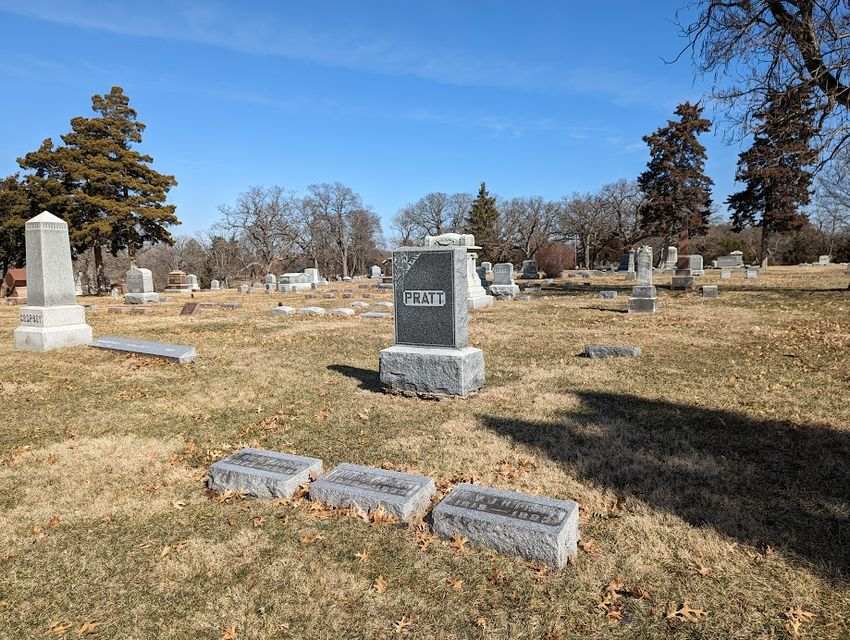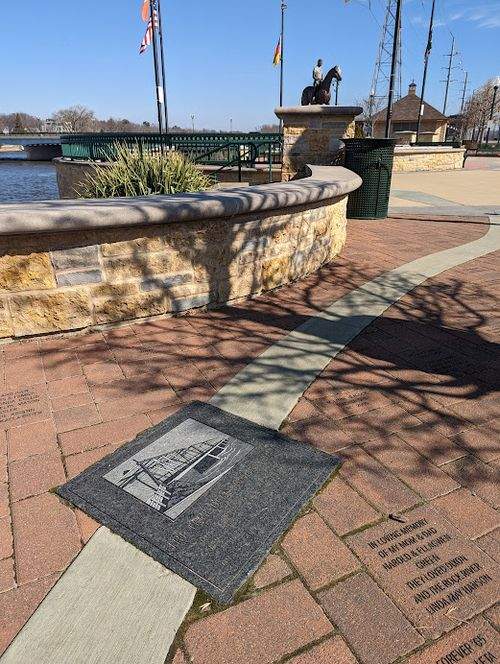Truesdell Bridge Disaster
Originally published in The Rock River Times.
Dixon, Illinois has always been an important city because it has been a crossing point for the Rock River for centuries. The first white settler in the area was a man of French descent named Ogee that built a cabin along the riverbank in 1828. One of Ogee’s major contributions was continuing a ferry that had been operated by the Native Americans that lived in the area for years. Ogee sold his land to John Dixon, who became the town’s namesake.
The first bridge to cross the Rock River at this point was built around 1846. Between 1846 and 1868, there were eight bridges built to cross the river at Dixon. These only lasted a few years each because of the periods of high water and flooding which brought large amounts of debris down the river. This debris smashed into the bridges causing them to break apart quickly.
Eventually, city officials decided to look for bridges designed with better materials that would outlast the wooden bridges. The proposal required a bridge that was six hundred sixty feet long. It would be quite an engineering marvel for that period.
City authorities looked at many different plans before finally deciding on a bridge made from iron that was designed by L.E. Truesdell from Massachusetts. Truesdell designed other bridges in Illinois but none of his previous projects were as long as the Dixon bridge required. Not all the people involved were convinced that Truesdell’s design was the best, but their doubts were silenced by the majority.
The bridge was built for a cost of $83,000. It opened to great fanfare January 21, 1869, with music and a parade to highlight the accomplishment. Large loads were carried across the bridge to show the sturdiness of the design.
Four years later on May 4, 1873, all seemed well with the bridge. Reverend J. H. Pratt from the Baptist Church had scheduled a special event for the Baptist Church for that day. Pratt had been Reverend of the church for about nine years by 1873. This year his flock had brought in six new candidates to the church and the reverend wanted to highlight this success with a special occasion. He scheduled a mass baptism that would involve full-immersion in the river. People gathered all along the banks and onto the bridge for a chance to watch the ceremony. There were even families in carriages that stopped on the bridge.
One of the excited onlookers was 18-year old Clara Stackpole. Clara had a busy schedule that day but she brought her little sister Rosa to see the baptism. This was to be Clara’s last day in Dixon. She was moving to Chicago where she was scheduled to begin work as a teacher. It would be an understatement to say that Clara was excited. Her little sister, Rosa was only 10 years old in 1873. Both girls were well known with their community.
Another family that joined the crowd was part of the Dana family. Minnie Dana was 7 years old and attended with her mother’s sister, Agnes Nixon. Agnes was 17 years old and staying with the Dana family.
Most of the candidates that were being baptized that day were young women who had moved to the area to work in the factories. Their families came to take part in the event and were proudly watching the festivities. Later, it was estimated that at least 200 people lined the bridge for the event.
The first two baptisms went as expected. When the third woman stepped into the water and the choir began to sing once again, another sound rose. As the voices of the choir swelled a horrible shrieking noise rose above the music. At first the crowd stood stunned, confused by the sound that rose above all others. Then as the realization of what was actually happening rushed over them, the folks on the bridge began to move. The mass of people turned almost as one and made toward the closest bank. But they moved too late and only a handful on each end of the bridge escaped.
The iron tresses which had seemed so decorative only minutes before became like giant metal jaws as they closed down over the helpless people standing on the bridge. The jaws ripped flesh before it fell, dragging the victims into the water below. Over 175 people were dumped into the river.
Almost as soon as the shrieking of the bridge stopped, it was replaced by a sound even more terrible than the one before. Screams from family members filled the air as people began to realize what had just taken place. The screams were soon joined by the wails of the wounded.
Grown men were screaming for their children and wives, women that were there to witness their co-workers or friends welcomed into the house of God, fainted at the sight of the mangled bodies piled under the wreckage. Some witnesses were struck by the fact that one moment the day was bright and shining as if the heavenly gates were thrown open to celebrate this joyous occasion and the next moment it was as if the Angel of Death himself had spread his dark wings over everyone and everything.
Help began to arrive almost immediately. Men jumped in to save the survivors. Many victims were pulled up on the bank to safety. The injured were grabbed by others who carried them to the nearest houses to set up makeshift hospitals. Wooden planks from the bridge were used to pull both living and dead victims from the water. One man mentioned in the newspapers of the day was William Dailey who saved at least 16 people single handedly with a plank from the broken bridge.
The houses closest to the river were quickly filled with the injured, the dying and the dead. Family members staggered from house to house looking for their loved ones. Heartbreaking scenes took place of family members reunited after hours of searching after thinking all hope was lost, only to find their loved ones alive. And the other scenes, even more heart wrenching, of people searching through the crowds of survivors, only to find their family members laid out on the bank in the makeshift morgues.
Special machines arrived to help lift the wreckage so that they could search for the missing bodies with long lines containing grappling hooks at the end. After 11 days the last of the missing was found. One body, that of 17-year-old Lizzie Mackey was found by the dam in Sterling over 14 miles downstream of the accident.
Minnie Dana and her Aunt Agnes and the Stackpole sisters were in the mass of dead and dying caught in the river. Little Minnie was pulled out alive but died shortly afterwards. Her Aunt Agnes was found trapped in the metal work of the bridge. The men who were recovering the bodies were heartbroken at the sight of the victims, especially the young children like Rosa and Minnie. These men would talk of seeing the faces of the victims in their nightmares even years later.
It is no surprise that there was a lot of finger pointing after this disaster. One surprise though was the people who blamed the Baptist Church for the accident. The emotions against the Baptists rose so high that the newspaper felt the need to comment. “There are some people in this town—those in the habit of censuring Christians whenever they have an opportunity—who consider the Baptists, especially the Rev. J. H. Pratt, the minister who was immersing the converts, responsible for the accident. This is unfair …”
Reverend Pratt must have been devastated by the tragedy. He left the church in Dixon by the end of the year and moved away. He was brought back to Dixon ten years later to be buried in Oakwood Cemetery. In fact, he is buried near Clara and Rosa Stackpole.
The news of this accident spread quickly. The Dixon Sun reported that it had spread around the world by the next day. Some of the headlines in the different papers told the tale, “Baptism of Death” , “Dixon Horror”, “The Great Bridge Murder.”
This accident shut the town down for days. Businesses and schools stayed closed as folks mourned their dead. In the end, 46 people lost their lives. 37 of those that died were females while 9 were male. The focus in town was the cleanup and the churches were the busiest places in town as funerals were held for the victims.
A Coroner’s Jury was gathered the next day, but the emotions were so high on both sides that it was hard to determine where the true issue of blame should rest. Some blamed the City Council while others felt that the City authorities had been tricked by Truesdell. The Dixon Sun reported on May 7, ““Give no ear to those men who accuse their neighbors of murder, as stated in the Chicago Times. Many good men believed the Truesdell bridge to be a perfect structure, and were as honest in their belief as those who were of a contrary opinion. Scientific men and bridge builders knew the faults of the miserable structure; and the rotten iron of which it was built was well known to the rotten contractors.”
Truesdell never built another bridge. He opened a silver mine back east. It eventually failed. Truesdell died in 1890 and was buried in Massachusetts.
This year will mark the 150th Anniversary of this dark day in Dixon’s history. There are two different plaques on the riverwalk to honor those killed. Many articles have been written about this terrible event and they all contained many tales of heroic deeds conducted by ordinary men that would later say that only did what anybody else would have done. Though this tragedy took place so long ago, the courage and compassion demonstrated by those heroes, the survivors, and the family members of those lost is awe inspiring.
Killed
Mrs. P.M. Alexander, Dixon
Mrs. Peter Corney, Dixon
Miss Kate Sterling, Dixon
Miss Maggie O’Brien, Dixon
Miss Ida Vann, Dixon
Miss Agnes Nixon, Dixon
Miss Irene Baker, Dixon
Mrs. Col. H.T. Noble, Dixon
Miss Rosa Stackpole, Dixon
Mrs. Carpenter, Dixon
Frank Hamilton, Dixon
Mrs. William Cook, Nelson
Mrs. Peterborger and daughter, Dixon
Mrs. Thomas Wade, Dixon
Miss Mary Sullivan, Dixon
Mrs. Elias Hope
Mrs. Henry Sallman, Dixon
Jay H. Mason, Dixon
Thomas Haley, Dixon
Mrs. James Goble, Bloomington
Miss Melissia Wilholm, Nachusa
Mrs. Dr. Hoffman, Dixon
Miss Nettie Hitt, Dixon
Miss Ida Drew, Dixon
Miss Bessie Rayne, Chicago
Mrs. J.W. Latta, Dixon
Miss Clara Stackpole, Dixon
Mrs. Benjamin Gillman, Dixon
Daughter of J.P. Danna, Dixon
Miss Emily Deming, Dixon
Mrs. Merriman, Dixon
Mrs. C.W. Kentner, Dixon
Abram Hope, Dixon
Miss Catherine Foley, Dixon
Mrs. E. Wallace, Dixon
George W. Kent, Dixon
Robert Dyke, Dixon
Copyright © 2023 Kathi Kresol, Haunted Rockford Events







